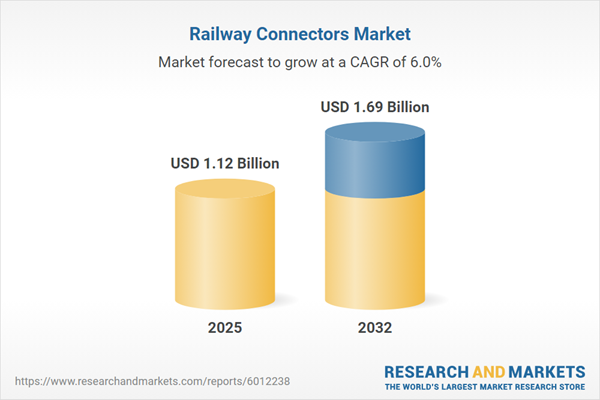Speak directly to the analyst to clarify any post sales queries you may have.
The railway connectors market is advancing as next-generation infrastructure upgrades and digital transformation projects accelerate globally. Leading rail operators and manufacturers now pivot toward solutions that optimize connectivity, performance, and system resilience across both freight and passenger applications.
Railway Connectors Market Snapshot
The Railway Connectors Market grew from USD 1.06 billion in 2024 to USD 1.12 billion in 2025. It is expected to continue growing at a CAGR of 6%, reaching USD 1.69 billion by 2032. This growth is underpinned by ongoing investments in rail electrification, increased adoption of high-speed lines, and wide-ranging digitalization efforts in major rail corridors.
Scope & Segmentation
- Distribution Channels: Direct sales, distributor partnerships, online procurement
- End Users: Freight rail operators, passenger rail operators
- Mounting Types: Surface mount, through hole
- Applications: Infrastructure, rolling stock for freight and passenger carriages, signaling (interlocking systems, track circuits)
- Material Types: Composites, metal alloys (aluminum, copper, steel), plastic
- Connector Types: Board-to-board, cable assemblies for power and signal transmission, circular, coaxial, rectangular connectors
- Regions: Americas (including North and Latin America), Europe, Middle East & Africa, Asia-Pacific. Extensive country-level coverage (United States, Canada, Brazil, United Kingdom, Germany, China, India, and others)
- Competitors: TE Connectivity, Amphenol, Molex LLC, Aptiv Technologies, Rosenberger, HARTING, Phoenix Contact, Weidmüller, LEMO SA, ITT Inc.
Key Takeaways
- Rapid technological advances are redefining connector roles in rail ecosystems. Integration with digital signaling and monitoring systems shapes demand for highly reliable, real-time data connectors.
- Material innovation, including the use of recyclable composites and advanced metal alloys, is increasingly critical as industry players prioritize both mechanical performance and sustainability initiatives.
- Procurement strategies are evolving, with digital marketplaces advancing component sourcing and qualification, and a growing emphasis on regional manufacturing to strengthen supply chain resilience.
- Regional dynamics drive diverse product requirements, such as weather-resistant solutions in the Americas, modularity for compliance in Europe, and automation-ready designs in the Asia-Pacific market.
- Strategic partnerships between connector manufacturers, rail operators, and system integrators are shortening development cycles and enhancing system interoperability.
Tariff Impact
Upcoming United States tariffs on imported connector components are expected to reshape sourcing strategies and cost structures for manufacturers and system integrators. These policy changes encourage qualification of regional production sites, deeper collaboration with local suppliers, and adoption of nearshoring models to preserve margins and ensure supply continuity. Companies are also reevaluating supplier agreements to address potential fluctuations in regulatory costs. Changes in global trade dynamics are driving adjustments across logistics networks and procurement hubs, requiring proactive risk management and scenario planning.
Methodology & Data Sources
This report applies a rigorous blend of qualitative and quantitative research, including in-depth reviews of industry literature, primary interviews with technical and operational experts, and analytics from proprietary databases. Data validation relies on triangulation across multiple sources and peer benchmarking to ensure accurate, actionable intelligence.
Why This Report Matters
- Gain targeted insights to optimize product portfolios, supply chain models, and go-to-market strategies within the evolving railway connectors market.
- Understand the nuanced requirements by region, application, and customer profile to better align innovations and commercial priorities.
- Respond proactively to regulatory shifts, sustainability trends, and digital transformation drivers across key rail markets.
Conclusion
By leveraging this intelligence, senior decision-makers are equipped to navigate technical, commercial, and regulatory shifts shaping the global railway connectors landscape. Strategic planning rooted in these findings can drive innovation, stability, and growth in upcoming investment cycles.
Additional Product Information:
- Purchase of this report includes 1 year online access with quarterly updates.
- This report can be updated on request. Please contact our Customer Experience team using the Ask a Question widget on our website.
Table of Contents
3. Executive Summary
4. Market Overview
7. Cumulative Impact of Artificial Intelligence 2025
Companies Mentioned
The companies profiled in this Railway Connectors market report include:- TE Connectivity Ltd.
- Amphenol Corporation
- Molex LLC
- Aptiv Technologies Limited
- Rosenberger Hochfrequenztechnik GmbH & Co. KG
- HARTING Electronics GmbH & Co. KG
- Phoenix Contact GmbH & Co. KG
- Weidmüller Interface GmbH & Co. KG
- LEMO SA
- ITT Inc.
Table Information
| Report Attribute | Details |
|---|---|
| No. of Pages | 184 |
| Published | October 2025 |
| Forecast Period | 2025 - 2032 |
| Estimated Market Value ( USD | $ 1.12 Billion |
| Forecasted Market Value ( USD | $ 1.69 Billion |
| Compound Annual Growth Rate | 6.0% |
| Regions Covered | Global |
| No. of Companies Mentioned | 11 |









